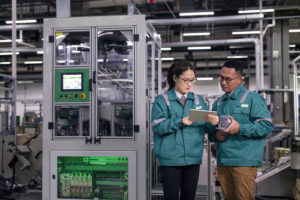According to the ARC Advisory Group, about $65 billion in installed process automation systems worldwide are reaching end of life, with most having been in operation for over 20 years. As these aging systems phase out at an accelerated rate, these closed, proprietary devices are being upgraded to more open, more intelligent processor-based devices that enable a newer, high degree of interoperability. Since increased interoperability is helping to drive productivity and lower operational costs in plants, industrial stakeholders are benefitting.
At the center of this modernization wave are two important cornerstones:
- Ethernet Programmable Automation Controllers (ePACs) that allow operators real-time control and information sharing
- An Ethernet backbone that has emerged as a key catalyst for opening the floodgates of connectivity and high-speed communications.
The integration of Ethernet and ePACs now allows the network to become the controller within a distributed intelligence configuration. This serves to break down barriers to real-time data access and eliminates time latency and inconsistency, thereby permitting the sharing of data at all levels of industrial organizations.
The acceleration of the ePACs/Ethernet evolution will change the way industrial organizations pursue growth. Listed below are a few of the more notable outcomes:
Standardization benefits
The Water & Wastewater, Food & Beverage, Metals & Mining, Hydropower, and Cement & Glass industries all depend upon reliable interoperability among their diverse installed base of automation products. Ethernet is a boon to these industries because it provides standardization via an open protocol. The ePACs support standardization efforts as well because this single product group can provide a large percentage of the required control functionality.
Flexibility benefits
The ePACs architecture is geared to maximizing production flexibility, data and information transparency, and openness for local and remote diagnostics. Industrial enterprises need to be able to change automation configurations and architectures on the fly, without disrupting production processes. Ethernet connectivity contributes by allowing for bi-directional communications with on-premise or cloud-based enterprise applications, such as enterprise resource planning (ERP), manufacturing execution systems (MES), enterprise asset management (EAM), and supply chain management (SCM).
Predictive maintenance benefits
Since intelligent devices are now accessible via the Ethernet network, remote diagnostics can be performed so that issues or behavioral inconsistencies can be identified and tracked. This predictive maintenance approach avoids unscheduled downtime and initiates device repair before the device fails and impacts production. Such monitoring is available locally on HMI or SCADA systems, or remotely on web pages via smartphones or tablets.
Uptime benefits
The interoperability of ePACs and Ethernet technologies allows for simple modifications to applications, configurations, and architecture without interruptions to the production process. This includes “hot-swapping” modules or adding digital and analog I/O drops and devices directly onto the Ethernet network.
Product longevity benefits
For purchasers of industrial equipment, it can difficult to buy into a technology today that will still be available and recognized in 20 years. Architecture based on standard Ethernet protocols can guarantee long term sustainability, because of strong market acceptance and the openness of the technology.
Manageability benefits
Authorized users can configure and tune parameters for all Ethernet connected devices (like variable speed drives) from anywhere on the system. Therefore, from the supervisory control (SCADA, DCS) down to field operations, “big data” can be mined in order to both lower risk and drive enhanced performance. The Ethernet backbone also supports a dual I/O bus, which is critically important to supporting redundancy requirements for many process applications.
Schneider Electric partners play an important role in helping customers to migrate to ePAC/Ethernet-based automation control systems. For more information, visit our solutions page or download this free white paper from ARC Advisory Group.


